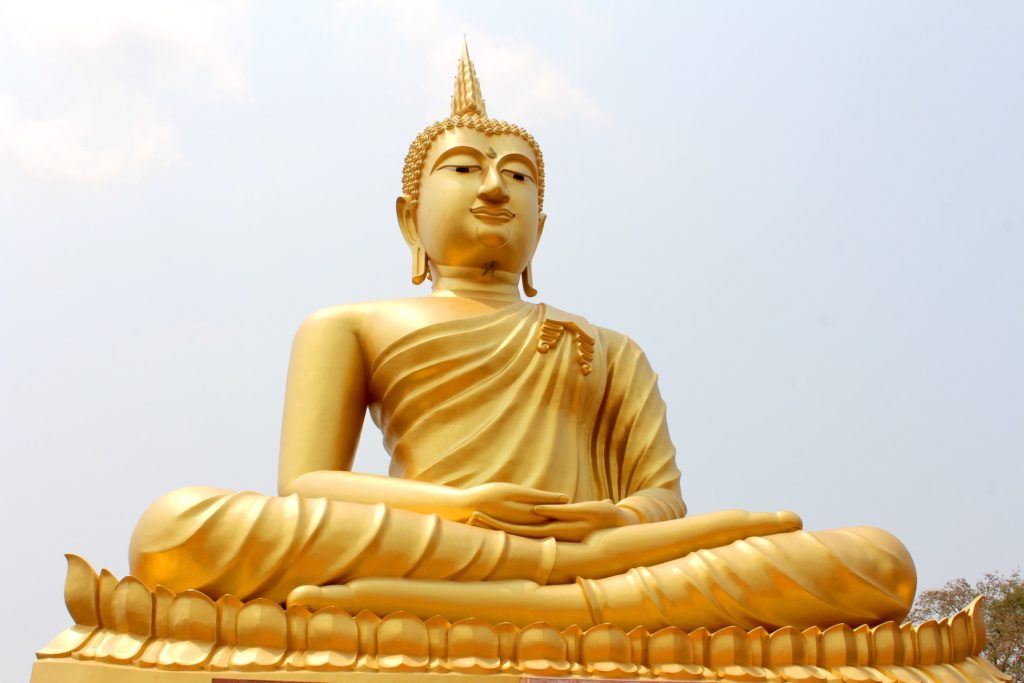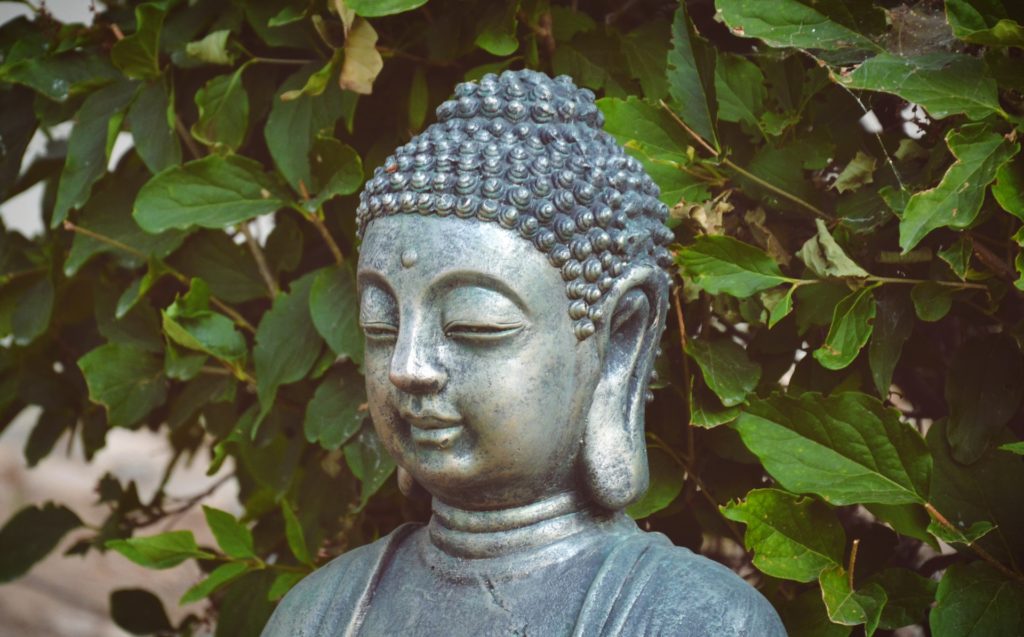
The history of Indian Buddhism may be divided into five periods: Early Buddhism (occasionally called pre-sectarian Buddhism), Nikaya Buddhism or Sectarian Buddhism: The period of the early Buddhist schools, Early Mahayana Buddhism, later Mahayana Buddhism, and Vajrayana Buddhism.
Pre-sectarian Buddhism
According to Lambert Schmithausen Pre-sectarian Buddhism is “the canonical period prior to the development of different schools with their different positions.”
The early Buddhist Texts include the four principal Nikāyas (and their parallel Agamas) together with the main body of monastic rules, which survive in the various versions of the patimokkha. However, these texts were revised over time, and it is unclear what constitutes the earliest layer of Buddhist teachings. One method to obtain information on the oldest core of Buddhism is to compare the oldest extant versions of the Theravadin Pāli Canon and other texts. The reliability of the early sources, and the possibility to draw out a core of oldest teachings is a matter of dispute. According to Vetter, inconsistencies remain, and other methods must be applied to resolve those inconsistencies.
According to Schmithausen, three positions held by scholars of Buddhism can be distinguished:
“Stress on the fundamental homogeneity and substantial authenticity of at least a considerable part of the Nikayic materials;”
“Scepticism with regard to the possibility of retrieving the doctrine of earliest Buddhism;”
“Cautious optimism in this respect.”

Core Teachings
According to Mitchell, certain basic teachings appear in many places throughout the early texts, which has led most scholars to conclude that Gautama Buddha must have taught something similar to the Four Noble Truths, the Noble Eightfold Path, Nirvana, the three marks of existence, the five aggregates, dependent origination, karma, and rebirth. Yet critical analysis reveals discrepancies, which point to alternative possibilities.
Bruce Matthews notes that there is no cohesive presentation of karma in the Sutta Pitaka, which may mean that the doctrine was incidental to the main perspective of early Buddhist soteriology. Schmithausen has questioned whether karma already played a role in the theory of rebirth of earliest Buddhism. According to Vetter, “the Buddha at first sought “the deathless” (amata/amrta), which is concerned with the here and now. Only later did he become acquainted with the doctrine of rebirth.” Bronkhorst disagrees, and concludes that the Buddha “introduced a concept of karma that differed considerably from the commonly held views of his time.” According to Bronkhorst, not physical and mental activities as such were seen as responsible for rebirth, but intentions and desire.
Another core problem in the study of early Buddhism is the relation between dhyana and insight. Schmithausen states that the four noble truths as “liberating insight”, maybe a later addition to texts such as Majjhima Nikaya 36.
According to both Bronkhorst and Anderson, the Four Noble Truths became a substitution for prajna, or “liberating insight”, in the suttas in those texts where “liberating insight” was preceded by the four jhānas. The four truths may not have been formulated in earliest Buddhism, and did not serve in earliest Buddhism as a description of “liberating insight”. Gotama’s teachings may have been personal, “adjusted to the need of each person.”
The three marks of existence – Dukkha, Annica, Anatta – may reflect Upanishadic or other influences. K.R. Norman supposes that these terms were already in use at the Buddha’s time, and were familiar to his hearers. According to Vetter, the description of the Buddhist path may initially have been as simple as the term “the middle way”. In time, this short description was elaborated, resulting in the description of the eightfold path. Similarly, nibbāna is the common term for the desired goal of this practice, yet many other terms can be found throughout the Nikāyas, which are not specified.

Early Buddhist Schools
According to the scriptures, soon after the parinirvāṇa (from Sanskrit: “highest extinguishment”) of Gautama Buddha, the first Buddhist council was held. As with any ancient Indian tradition, the transmission of teaching was done orally. The primary purpose of the assembly was to collectively recite the teachings to ensure that no errors occurred in oral transmission. Richard Gombrich states that the monastic assembly recitations of the Buddha’s teaching likely began during Buddha’s lifetime, similar to the First Council, that helped compose Buddhist scriptures.
The Second Buddhist council resulted in the first schism in the Sangha, probably caused by a group of reformists called Sthaviras who split from the conservative majority Mahāsāṃghikas. After unsuccessfully trying to modify the Vinaya, a small group of “elderly members”, i.e. sthaviras, broke away from the majority Mahāsāṃghika during the Second Buddhist council, giving rise to the Sthavira Nikaya.
The Sthaviras gave rise to several schools, one of which was the Theravada school. Originally, these schisms were caused by disputes over monastic disciplinary codes of various fraternities, but eventually, by about 100 CE if not earlier, schisms were being caused by doctrinal disagreements too. Buddhist monks of different fraternities became distinct schools and stopped doing official Sangha business together, but continued to study each other’s doctrines.
Following (or leading up to) the schisms, each Saṅgha started to accumulate their own version of Tripiṭaka (Pali Canons, a triple basket of texts). In their Tripiṭaka, each school included the Suttas of the Buddha, a Vinaya basket (disciplinary code) and added an Abhidharma basket which were texts on detailed scholastic classification, summary and interpretation of the Suttas. The doctrine details in the Abhidharmas of various Buddhist schools differ significantly, and these were composed starting about the third century BCE and through the 1st millennium CE. Eighteen early Buddhist schools are known, each with its own Tripitaka, but only one collection from Sri Lanka has survived, in a nearly complete state, into the modern era.

Early Mahayana Buddhism
Several scholars have suggested that the Mahayana Buddhist tradition started in south India (modern Andhra Pradesh), and it is there that Prajnaparamita sutras, among the earliest Mahayana sutras, developed among the Mahāsāṃghika along the Kṛṣṇa River region about the 1st century BCE.
There is no evidence that Mahayana ever referred to a separate formal school or sect of Buddhism, but rather that it existed as a certain set of ideals, and later doctrines, for bodhisattvas. Initially, it was known as Bodhisattvayāna (the “Vehicle of the Bodhisattvas”). Paul Williams states that the Mahāyāna never had nor ever attempted to have a separate Vinaya or ordination codes from the early schools of Buddhism. Records written by Chinese monks visiting India indicate that both Mahāyāna and non-Mahāyāna monks could be found in the same monasteries, with the difference that Mahayana monks worshipped figures of Bodhisattvas, while non-Mahayana monks did not.
Much of the early extant evidence for the origins of Mahāyāna comes from early Chinese translations of Mahāyāna texts. These Mahayana teachings were first propagated into China by Lokakṣema, the first translator of Mahayana sutras into Chinese during the 2nd century CE.[note 46] Some scholars have traditionally considered the earliest Mahāyāna sūtras to include the very first versions of the Prajnaparamita series, along with texts concerning Akṣobhya, which were probably composed in the 1st century BCE in the south of India.

Late Mahayana Buddhism
During the period of Late Mahāyāna, four major types of thought developed: Madhyamaka, Yogachara, Tathagatagarbha, and Buddhist logic as the last and most recent. In India, the two main philosophical schools of the Mahayana were the Madhyamaka and the later Yogachara. According to Dan Lusthaus, Madhyamaka and Yogachara have a great deal in common, and the commonality stems from early Buddhism. There were no great Indian teachers associated with tathagatagarbha thought.
Vajrayana (Esoteric Buddhism)
Scholarly research concerning Esoteric Buddhism is still in its early stages and has a number of problems that make research difficult:
Vajrayana Buddhism was influenced by Hinduism, and therefore research must include exploring Hinduism as well. The scriptures of Vajrayana have not yet been put in any kind of order. The rituals must be examined as well, not just doctrine.
